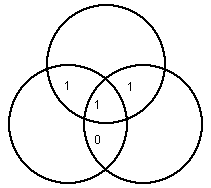
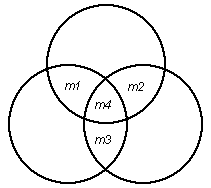
| COS 126 Hamming Codes in TOY |
Programming Assignment |
Write a TOY program to encode data using Hamming codes. Then write a TOY program to correct encoded data that has been corrupted.
Perspective. Error-correcting codes enable data to be sent through a noisy communication channel without corruption. To accomplish this, the sender appends redundant information to the message, so that even if some of the original data is corrupted during transmission, the receiver can still recover the original message intact. Transmission errors are common and can arise from scratches on a CD, static on a cell phone, or atmospheric interference. In a noisy environment, error-correcting codes can increase the throughput of a communication link since there is no need to retransmit the message if it becomes partially corrupted during transmission. For this reason, error-correcting codes are used in many common systems including: storage devices (CD, DVD, DRAM), mobile communication (cell phones, wireless, microwave links), digital television, and high-speed modems (ADSL, xDSL).
Hamming Codes. A Hamming code is a specific type of error-correcting code that allows the detection and correction of single-bit transmission errors. Hamming codes are used in many applications where such errors are common, including DRAM memory chips and satellite communication hardware. Hamming codes work by repeatedly reading four message bits, which we denote by m1, m2, m3, m4, and then inserting three parity bits, which we denote by p1, p2, and p3. If any one of these seven bits is corrupted during transmission, the receiver can detect the error and recover the original four message bits intact. This is called single-bit error correction because at most one bit can be corrected per unit of data sent. The overhead for using this method is a 75% increase in bandwidth because it requires three extra parity bits for every four message bits. This compares favorably with the naive approach of sending three copies of each bit (and using the one that appears most frequently), which results in a 200% increase in bandwidth.
Before we describe the algebra of Hamming codes, we first visualize the calculation of the parity bits using Venn diagrams. As an example, suppose we wish to send the message 1101. We associate each of the four message bits with a specific intersection region of three pairwise overlapping circles, as illustrated below:


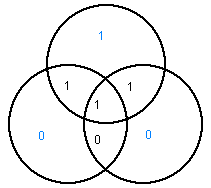
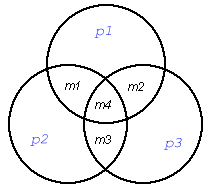
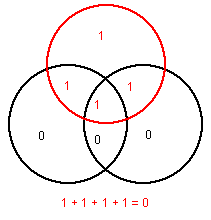
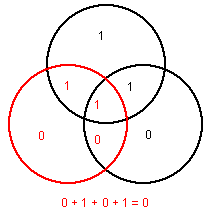
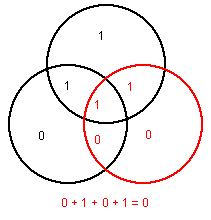
Now imagine this picture is transmitted over a noisy communication channel, and that one bit is corrupted so that the following picture arrives at the receiving station (corresponding to 1001100):
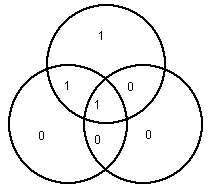
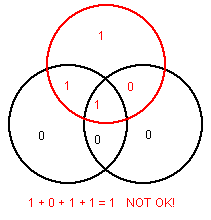
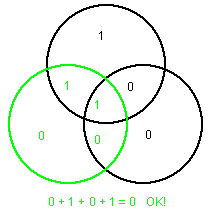
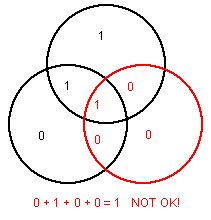
If the center bit m4 is corrupted, then all three parity checks will fail. If a parity bit itself is corrupted, then only one parity check will fail. If the communication channel is so noisy that two or more bits are simultaneously corrupted, then the scheme will not work. Can you see why? More sophisticated types of error-correcting codes can handle such situations.
Of course, in practice, only the 7 bits are transmitted, rather than the circle diagrams.
Part 1. Write a TOY program encode.toy to encode a binary message using the scheme described above. Your program should repeatedly read four bits m1, m2, m3, and m4 from TOY standard input until reading in FFFF and write the seven bits m1, m2, m3, m4, p1, p2, p3 to TOY standard output, where
Recall that ^ is the exclusive or operator in Java and TOY. This captures the parity notion described above.Part 2. Write a TOY program decode.toy to correct a Hamming encoded message. Your program should repeatedly read seven bits m1, m2, m3, m4, p1, p2, p3 from TOY standard input until reading in FFFF and write four bits to TOY standard output. Recall, to determine which one, if any, of the message bits is corrupted, perform the following three parity checks:
Input format. For convenience, we'll transmit each bit individually (as 0000 or 0001), instead of packing 16 bits per TOY word as would be done in a real application. Your programs should repeatedly read in four or seven bits from standard input until FFFF appears on TOY standard input. The number of transmitted bits (not including the terminating FFFF) will be a multiple of four when encoding and a multiple of seven when decoding.
The files provided this week include sample inputs for encode.toy and decode.toy, such as the one illustrated below.
% more encode3.txtNote that the line breaks are not essential, but are included for readability.
0001 0001 0000 0001
0001 0001 0001 0000
0001 0001 0001 0001
FFFF
Files for this assignment. Obtain the files this week as either as hamming.zip or by copying the hamming directory from the course FTP site (instructions). These files include programs in Java that illustrate the encoding and decoding procedures, sample input and output files for both encode.toy and decode.toy, the TOY reference card, the readme.txt template, a sample TOY program (multiply.toy), and TOY.java which is a TOY simulator.
Using the TOY simulator. To execute your TOY program, use either the command-line simulator TOY.java or alternatively use the Visual X-TOY simulator. For example, once you finish the first part correctly, running
% java-introcs TOY encode.toy < encode3.txtat the Terminal/Command Prompt will run it on the sample input file illustrated above, and should produce the following correct output (and some core dumps — see the checklist):
0001
0001
0000
0001
0001
0000
0000
0001
0001
0001
0000
0000
0000
0000
0001
0001
0001
0001
0001
0001
0001
Documenting. Use comments in your TOY program to describe what each line does. This will help you with development. Put a header at the top of your TOY programs. See multiply.toy for an example of what a TOY program should look like. In the readme file, you will also describe what you used each of the registers for in your programs.
Submission. Submit encode.toy, decode.toy, and a completed readme.txt. The "Check All Submitted Files" button will run your encode.toy and decode.toy programs on input files with three sample runs.
Extra credit. Rewrite decode.toy using the fewest number of (nonzero) words of TOY main memory. We will award extra credit for any solution that uses 39 (in decimal) or fewer; the current best is 29. Be sure to save your working version before attempting this!